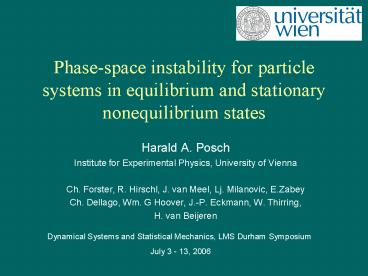Phase-space instability for particle systems in equilibrium and stationary nonequilibrium states - PowerPoint PPT Presentation
Title:
Phase-space instability for particle systems in equilibrium and stationary nonequilibrium states
Description:
Hard disks: Generators of symmetry transformations. N = 780. Classification of modes ... Fractal phase-space probability is fingerprint of Second Law ... – PowerPoint PPT presentation
Number of Views:32
Avg rating:3.0/5.0
Title: Phase-space instability for particle systems in equilibrium and stationary nonequilibrium states
1
Phase-space instability for particle systems in
equilibrium and stationary nonequilibrium states
- Harald A. Posch
- Institute for Experimental Physics, University of
Vienna - Ch. Forster, R. Hirschl, J. van Meel, Lj.
Milanovic, E.Zabey - Ch. Dellago, Wm. G Hoover, J.-P. Eckmann, W.
Thirring, - H. van Beijeren
Dynamical Systems and Statistical Mechanics, LMS
Durham Symposium July 3 - 13, 2006
2
Outline
- Localized and delocalized Lyapunov modes
- Translational and rotational degrees of freedom
- Nonlinear response theory and computer
thermostats - Stationary nonequilibrium states
- Phase-space fractals for stochastically driven
heat flows and Brownian motion - Thermodynamic instability
- Negative heat capacity in confined geometries
3
Lyapunov instability in phase space
4
Perturbations in tangent space
5
Lyapunov spectra for soft and hard disks
- Left 36 soft disks, rho 1, T 0.67
- Right 400 disks, rho 0.4, T 1
6
Properties of Lyapunov spectra
- Localization
- Lyapunov modes
7
Localization
8
102.400 soft disks
- Red Strong particle contribution to the
perturbation associated with the maximum Lyaounov
exponent, - Blue No particle contribution to the maximum
exponent.
Wm.G.Hoover, K.Boerker, HAP, Phys.Rev. E 57, 3911
(1998)
9
Localization measure at low density 0.2
T. Taniguchi, G. Morriss
10
N-dependence of localization measure
11
N 780 hard disks, ? 0.8, A 0.8, periodic
boundaries
12
N 780
13
Hard disks, N 780, ? 0.8, A 0.867
- Transverse mode T(1,1) for l 1546
14
Continuous symmetries and vanishing Lyapunov
exponents
15
Hard disks Generators of symmetry transformations
16
N 780
17
Classification of modes
18
Classification for hard disksRectangular box,
periodic boundaries
19
Hard disks Transverse modes, N 1024, ? 0.7,
A 1
20
Lyapunov modes as vector fields
21
Dispersion relation
- N 780 hard disks, ? 0.8, A 0.867
22
Shape of Lyapunov spectra
23
Time evolution of Fourier spectra
24
Propagation of longitudinal modes
N 200, density 0.7, Lx 238, Ly 1.2
25
LP(1,0), N 780 hard disks, ? 0.8, A
0.867reflecting boundaries
26
LP(1,1), N780 hard disks, ?0.8, A0.867
reflecting boundaries
27
N 375
28
Soft disks
- N 375 WCA particles, ?? 0.4 A 0.6
29
Power spectra of perturbation vectors
30
Density dependence hard and soft disks
31
Rough Hard Disks and Spheres
Hard disks
32
Rough particles collision map
33
N 400, ? 0.7, A 1
34
N 400, ? 0.7, A 1
35
Convergence
? 0.5, A 1, I 0.1
36
(No Transcript)
37
Rough hard disks N 400
38
Localization, N 400, I 0.1, density 0.7
39
Summary I Equilibrium systems with short-range
forces
- Lyapunov modes formally similar to the modes of
fluctuating hydrodynamics - Broken continuous symmetries give rise to modes
- Unbiased mode decomposition
- Soft potentials require full phase space of a
particle - Hard dumbbells, ......
- Applications to phase transitions, particles in
narrow channels, translation-rotation coupling,
......
40
Response theory
41
Time-reversible thermostats
42
Isokinetic thermostat
43
Stationary States Externally-driven Lorentz gas
44
B.L.Holian, W.G.Hoover, HAP, Phys.Rev.Lett. 59,
10 (1987), HAP, Wm. G. Hoover, Phys. Rev A38,
473 (1988)
45
Externally-driven Lorentz gas
46
(No Transcript)
47
Frenkel-Kontorova conductivity, 1d
48
Stationary nonequilibrium states IIThe case for
dynamical thermostats
- qpzx-oscillator
49
Stationary Heat Flow on a Nonlinear
LatticeNose-Hoover ThermostatsHAP and
Wm.G.Hoover, Physica D187, 281 (2004)
50
Control of 2nd and 4th moment
51
Extensivity of the dimensionality reduction
52
Stochastic ?4 lattice model
53
Temperature field, Lyapunov spectrum
54
Projection onto Newtonian subspace
55
Summary II
- Fractal phase-space probability is fingerprint of
Second Law - Insensitive to thermostat dynamical or
stochastic - Sum of the Lyapunov exponents is related to
transport coefficient - Kinetic theory for low densities and fields
- (Dorfman, van Beijeren, ..... )
56
Unstable Systems
57
Negative heat capacity
58
Stability of stars
59
B Heating of cluster core C Cooling at boundary
- HAP and W. Thirring, Phys. Rev. Lett 95, 251101
(2005)
60
Jumping board model (PRL 95, 251101 (2005)
61
Jumping board model
62
Jumping board model
63
(No Transcript)
64
(No Transcript)
65
N 1000 particles
66
(No Transcript)
67
Coupled systems
68
Uncoupled systems
69
(No Transcript)
70
Coupled systems, N(P) N(N) 1
71
Summary III
- Systems with clt0 more-than-exponential energy
growth of phase volume - Jumping-board model gas of interacting particles
in specially-confined gravitational box - Problems with ergodicity
72
Self-gravitating system Sheet model
73
Chaos in the gravitational sheet model
74
Sheet model non-ergodicity
75
Family of gen. sheet models Hidden symmetry?
- Lj. Milanovic, HAP abd W. Thirring, Mol. Phys.
2006
76
Gravitational particles confined to a box
Case A E const
77
Case B energy E const angular momentum L 0
Case C energy E const linear momentum P 0
78
3 particles in external potential
79
3 particles in reflecting box
80
Summary IVGravitational collapse and ergodicity
- Sheet model Lack of ergodicity for
thirty-particle system - Symmetric dependence on parameter
- Hint of additional integral of the motion
- Stabilization by additional conserved quantities































